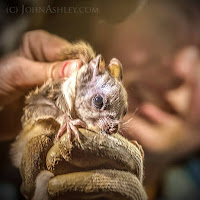 Our northern flying squirrel (Glaucomys sabrinus) is built to work the night shift. Our daytime red squirrel (Tamiasciurus hudsonicus) returns to its nest before dusk because it can't see in dim light. But even though the flying squirrel is considerably smaller than its daytime cousin, its eyes are twice as large to gather more light at night. While red squirrel eyes have mostly color-detecting cone cells, flying squirrel eyes have mostly dim light-detecting rod cells.
Our northern flying squirrel (Glaucomys sabrinus) is built to work the night shift. Our daytime red squirrel (Tamiasciurus hudsonicus) returns to its nest before dusk because it can't see in dim light. But even though the flying squirrel is considerably smaller than its daytime cousin, its eyes are twice as large to gather more light at night. While red squirrel eyes have mostly color-detecting cone cells, flying squirrel eyes have mostly dim light-detecting rod cells.Like other nocturnal animals, flying squirrels also have "mirror" behind their retinas that reflects dim light back to the rod cells, effectively amplifying their night vision. This tapetum layaccounts for some of the animal eyes that you and I see when we shine a flashlight into the dark -- our light reflects off the animal's tapetum bright enough for our eyes to see.


